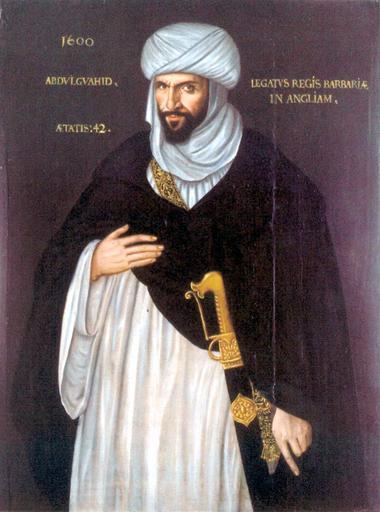MAKE A MEME
View Large Image

| View Original: | Abd_el-Ouahed_ben_Messaoud_ben_Mohammed_Anoun,_Moorish_ambassador_to_Elizabeth_I,_who_may_have_been_the_inspiration_for_the_character_Othello.jpg (510x688) | |||
| Download: | Original | Medium | Small | Thumb |
| Courtesy of: | www.flickr.com | More Like This | ||
| Keywords: shakespeare tudors elizabeth i elizabethi portrait 16th century 16thcentury Abd el-Ouahed ben Messaoud ben Mohammed Anoun (1558-?) was principal secretary to the Moroccan ruler "Muly Hamet" (Mulai Ahmad al-Mansur), and ambassador to the court of Queen Elizabeth I of England in 1600, to promote the establishment of an Anglo-Moroccan alliance. The visit of Abd el-Ouahed ben Messaoud followed the sailing of The Lion in 1551, and the 1585 establishment of the English Barbary Company, which had the objective of developing trade between England and Morocco.Vaughan, p.57 Diplomatic relations and an alliance were established between Elizabeth and the Barbary states. The last years of the 16th century saw major English successes against Spain, with the English victory against the Spanish Armada in 1588, and the Capture of Cadiz by the Earl of Essex in 1597, and also Moroccan successes against Spain at the Battle of Alcazar in 1578. Emboldened by these successes, Muly Hamet decided to send an embassy to propose a joint invasion of Spain. Abd el-Ouahed ben Messaoud was accompanied by al Hage Messa and al Hage Bahanet, as well as an interpreter named Abd el-Dodar, an Andalusian by birth, under cover of a trade mission to Aleppo with a stopover in London.Nicoll, p.91 Altogether, the embassy numbered 16 (including some prisoners being returned to England), and sailed onboard The Eagle under Robert Kitchen. He reached Dover on 8 August, 1600. Abd el-Ouahed ben Messaoud spent 6 months at the court of Elizabeth, at the age of 42, in order to negotiate an alliance against Spain. Abd el-Ouahed ben Messaoud spoke some Spanish, but he communicated to the queen through his interpreter who spoke in Italian. They met with the queen on August 19,Nicoll, p92 and again on September 10. The Moroccan ruler wanted the help of an English fleet to invade Spain, Elizabeth refused, but welcomed the embassy as a sign of insurance, and instead accepted to establish commercial agreements.Vaughan, p.57 Queen Elizabeth and King Hamet continued to discuss various plans for combined military operations, with Elizabeth requesting a payment of 100,000 pounds in advance to King Hamet for the supply of a fleet, and Hamet asking for a tall ship to be sent to get the money. Discussions however remained inconclusive, and both rulers died within two years of the embassy. The painting of Abd el-Ouahed ben Messaoud is visible at the Shakespeare Institute at Stratford-upon-Avon. It has been suggested that the figure of Abd el-Ouahed ben Messaoud may have inspired the character of Shakespeare's Moorish hero Othello. Abd el-Ouahed ben Messaoud ben Mohammed Anoun (1558-?) was principal secretary to the Moroccan ruler "Muly Hamet" (Mulai Ahmad al-Mansur), and ambassador to the court of Queen Elizabeth I of England in 1600, to promote the establishment of an Anglo-Moroccan alliance. The visit of Abd el-Ouahed ben Messaoud followed the sailing of The Lion in 1551, and the 1585 establishment of the English Barbary Company, which had the objective of developing trade between England and Morocco.Vaughan, p.57 Diplomatic relations and an alliance were established between Elizabeth and the Barbary states. The last years of the 16th century saw major English successes against Spain, with the English victory against the Spanish Armada in 1588, and the Capture of Cadiz by the Earl of Essex in 1597, and also Moroccan successes against Spain at the Battle of Alcazar in 1578. Emboldened by these successes, Muly Hamet decided to send an embassy to propose a joint invasion of Spain. Abd el-Ouahed ben Messaoud was accompanied by al Hage Messa and al Hage Bahanet, as well as an interpreter named Abd el-Dodar, an Andalusian by birth, under cover of a trade mission to Aleppo with a stopover in London.Nicoll, p.91 Altogether, the embassy numbered 16 (including some prisoners being returned to England), and sailed onboard The Eagle under Robert Kitchen. He reached Dover on 8 August, 1600. Abd el-Ouahed ben Messaoud spent 6 months at the court of Elizabeth, at the age of 42, in order to negotiate an alliance against Spain. Abd el-Ouahed ben Messaoud spoke some Spanish, but he communicated to the queen through his interpreter who spoke in Italian. They met with the queen on August 19,Nicoll, p92 and again on September 10. The Moroccan ruler wanted the help of an English fleet to invade Spain, Elizabeth refused, but welcomed the embassy as a sign of insurance, and instead accepted to establish commercial agreements.Vaughan, p.57 Queen Elizabeth and King Hamet continued to discuss various plans for combined military operations, with Elizabeth requesting a payment of 100,000 pounds in advance to King Hamet for the supply of a fleet, and Hamet asking for a tall ship to be sent to get the money. Discussions however remained inconclusive, and both rulers died within two years of the embassy. The painting of Abd el-Ouahed ben Messaoud is visible at the Shakespeare Institute at Stratford-upon-Avon. It has been suggested that the figure of Abd el-Ouahed ben Messaoud may have inspired the character of Shakespeare's Moorish hero Othello. | ||||